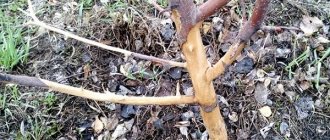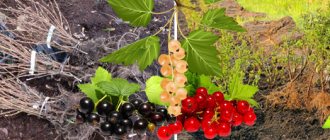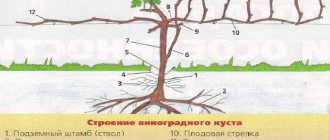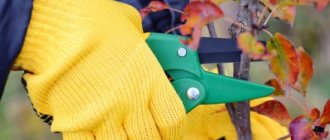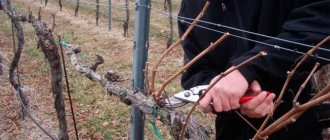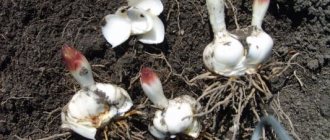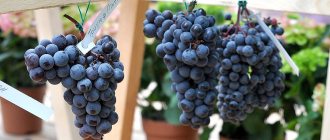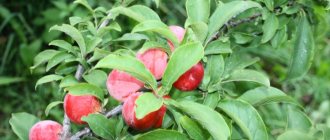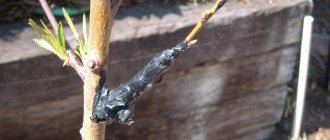Loading…
Loading…
In traditional viticultural regions, such as Spain or the south of France, the vines are pruned only in spring and autumn. At the same time, the removal of shoots is aimed at the formation of a bush, improvement and renewal of the vine. The further south the growing area, the more sun the berries get and the longer the growing season of the plant. The main problem with growing grapes and ripening berries in the middle zone is the lack of heat and light.
Summer pruning of grapes helps to partially compensate for the shortness of the Russian summer and create conditions for obtaining the highest quality harvest. It, unlike the spring one, does not affect the woody parts of the vine, but is aimed exclusively at green shoots, foliage and ovaries.
Therefore, operations carried out in the summer are often called green operations and include breaking and chasing shoots, removing stepsons, ringing, as well as crop regulation and thinning of leaves.
How to prune grapes before flowering?
After pruning in the spring, the gardener’s attention to the grape bushes should not weaken, since along with the fruit eyes, fatty shoots emanating from the old parts of the vine or from the base of the shoots also grow.
When and how to prune grapes in the summer from unnecessary shoots at this stage? Grapes are removed in the last ten days of May or early summer, when new green shoots reach a length of 15–20 cm and are easily removed. With proper cutting of shoots on the bush and pruning of grapes in the summer, you can achieve:
- the presence on each plant of a number of shoots corresponding to the strength of the bush;
- a good foundation for the complete ripening of shoots and the laying of a bountiful harvest;
- preserving the harvest from grape diseases and pest attacks;
- access of air and sun to the ovary;
- redirection of nutrition from parasitic shoots to the brushes;
- proper formation of the bush for next year.
If the tops are not broken off in time, they develop at the expense of nutrients, which at this time are extremely necessary for flowering and the formation of the ovary. In addition, fatty shoots shade the bush, prevent the penetration of air and sunlight into the crown and even prevent the formation of future berries.
At the same time, when pruning grapes in July or earlier, wild shoots growing from the underground part of the bush are removed, but cultivated shoots are left without inflorescences, if they are needed in the future for the formation of grapes. The stronger the plant, the more shoots are left.
Step-by-step instruction
So that every beginner can understand how to properly prune grapes in the summer, step-by-step instructions for carrying out such an event are provided. But first you need to remember a few rules:
- those shoots or shoots that are easily pinched and broken off are best removed by hand without using pruners;
- when removing empty vines, you must ensure that the shape of the bush does not change;
- When pruning fruit-bearing branches, at least 7 buds must be left on them.
Related article:
When to prune grapes
In general, all summer activities include procedures for pinching, removing tendrils, pinching, chasing, lightening (thinning out leaves), ringing and rationing of bunches.
Topping
This technique is used as the very first one even before flowering begins. Of all the activities described, this is the simplest. Young shoots are pinched with two fingers about 10 cm from the woody vine.
As a result of this procedure, the growth of pinched branches slows down significantly. Therefore, the main amount of water and nutrients are sent to fruiting shoots. The operation is performed twice with an interval of 10–15 days.
Removing antennae
The tendrils, which take away some of the juices and energy from the plant, can only be removed on tied vines, otherwise they will have nothing to hold onto for support. Pinching is carried out at the very base.
Related article:
Mistakes when pruning grapes
This event is performed throughout the summer season, since the antennae grow very quickly. Ideally, you need to pinch them off daily or with short breaks.
Stepsoning
Removing stepsons is a very common agricultural technique that many garden crops need. In the vineyard it is performed in June immediately after flowering.
During the procedure, the lateral shoots growing on the main stem at its junction with the leaf are removed. The stepsons are not pinched off completely, but up to half, leaving about 2 cm. If completely removed, a new shoot will immediately grow in the same place.
Coinage
Embossing is a special type of pinching, which differs in that it is performed at a distance of 40 cm from the stem. This technique accelerates the ripening of berries and is carried out during the fruiting period, starting in August.
Related article:
How to prune grapes in spring
The procedure itself has several nuances. Therefore, before pruning grapes in the summer, it will be useful for novice gardeners to first carefully understand its intricacies. If you carry out the chasing ahead of schedule or shorten the vine too much, then active growth of the stepsons will begin. In addition, you should not pinch shoots with leaves. Each of them should have at least 14 sheets left. It is advisable not to use pruners, but if you cannot do without them, then the cutting part should be disinfected.
Lightening
Pruning grapes in summer is most noticeable in cases where the leaves are removed and the bush immediately “lightens”. This event is carried out after the berries are formed in order to speed up their ripening.
Removal is carried out mainly on vines with clusters. At the same time, 6–10 of the lowest leaves are broken off so that they do not draw nutrients onto themselves. If the density is too strong, clarification is also carried out during the flowering period.
Related article:
Spring planting of grapes in the ground
Banding
Banding involves removing the bark around the fruiting shoot. This technique is quite complicated and requires maximum care.
The width of the ring being cut is 2–3 mm, and the cut itself should not damage the core. When performed correctly, this procedure increases the supply of nutrients to the berries, which speeds up their ripening and makes them larger than usual.
Rationing of bunches
The number of bunches needs to be regulated, especially in regions with short summers. Without this, the berries will not have time to ripen, since the plant does not have enough strength for them. To speed up ripening, even on a large shoot there should be no more than two bunches left.
In addition, the remaining bunches need to be cleared of poorly developed grapes. They not only take away nutrients, but can also lead to rotting of the remaining berries. To ensure proper care of grapes in the summer, pruning of the vines should be carried out in compliance with all the above recommendations.
Related article:
Early grape varieties for the middle zone
How to prune grapes in summer from unnecessary shoots
With the onset of spring, the nutrient reserves accumulated in the previous season in the roots of the grape bush and the overwintered aerial parts are sent to the growth points, including the apical parts of the shoots and inflorescences. If the development of the shoot is extremely active, the future clusters lack nutrients, the flowers begin to crumble, and the inflorescences can turn into tendrils.
In order not to lose the harvest, the tops with not yet opened leaves are pinched, which leads to the cessation of shoot growth, and the established inflorescences develop and produce an ovary. After watching a video about pruning grapes in the summer, the intricacies of this process and the compatibility of certain “green operations” become clear to beginning gardeners. For example, the removal of young apical parts of the shoot can be combined with cutting out the stepsons or normalizing the inflorescences.
The shoot is pinched in the middle of the internode above the first inflorescence. We can also use this technique if it is necessary to regulate the growth of the bush. By pinching out the strongest shoots, you can achieve the formation of more inflorescences next year.
Which ski move to choose for beginners
There are two main types of skiing: skating and classic skiing. For those who have not previously encountered skis, skates, or rollers, it is better to choose the classic move. It is simpler technically. If you are fond of figure skating or roller skating, ski training with skating will be easier and more familiar for you. Let's look at each style in more detail.
Classic move
Peculiarities of riding style and equipment selection include:
- The skis stand parallel to each other, the movement is vaguely reminiscent of regular running.
- For skiing, you need to choose skis of a certain length and stiffness (see information in a separate article on the website).
- You can train without poles; during the first step, the supporting leg is used for the point, and the leading leg is used for sliding.
- It is important not to miss the moment when speed is lost and to have time to push off from the surface. Otherwise the speed will be lost.
- During sliding, the body weight is completely transferred to the front leg, which allows you to press down the ski well and ensures stable movement in a given direction.
Skating move
Here you will need skate skis - they are selected according to weight and height - 10-15 cm less than classic skis for the same height of the athlete. Read more about choosing skis in this article. From the nuances of skating technique:
- The skating movement resembles skating on regular ice skates. The important thing here is to watch your arms and not swing them too much, which could cause you to fall.
- The starting position for skating is a stance with slightly bent knees and the body tilted forward, but the legs are not parallel to each other, but in a “V” shape (heels together, toes apart).
- At the beginning of the movement, the weight is transferred to one of the legs, and a push is made with it. You need to push off not with your entire ski, as in classical skiing, but with your edge.
- Next, sliding is carried out on the leading leg, at the conclusion of the movement, weight is transferred to it and a push is made with it.
Combined skiing
The technique is suitable for beginners as it combines the movements of both styles. Skis of medium length (or slightly longer than average) are selected for testing. During training, you can easily understand which technique suits you best.
How to prune grapes before and during flowering?
Removing the apical parts of shoots with 5–8 upper opening leaves is called stamping a grape bush. Young shoots grow as actively as possible simultaneously with the entry of grapes into the time of flowering and ovary formation. In this case, the growing top is fed by the leaves that have already opened in the lower part.
Is it possible to prune grapes in the summer, when the plant is preparing to flower, or is the ovary already forming? Yes, shortening shoots with opening inflorescences will not only not harm the future harvest, but will also help:
- prevent buds from falling off;
- get a bountiful harvest from the shoot;
- improve the quality of ripening berries;
- prevent the development of diseases associated with overcrowding, lack of nutrition, light and air.
This technique is most in demand on vigorous-growing varieties, and on grapes with a compact crown and weak growth, where during flowering there is almost no shedding of clusters, such pruning of grapes in the summer is not performed.
What is the best time for pinching?
The most optimal time for the procedure is before the grapes begin to bloom. Pinching during this period will increase the turnover of juice in the vine and ensure the flow of nutrients to the necessary parts of the plant.
After all, it is during the flowering period that the vine usually receives less nutrients and the flowering and pollination phase itself is worse, due to this the ovary can crumble especially badly. And it is precisely pinching that allows for the movement of juice through the vine, which will allow the formation of new ovaries.
Professional winegrowers and experienced gardeners prefer to carry out the prizing procedure weekly. The number of buds on the plant will increase, which means that the harvest will be larger and of better quality.
Video: “Grapes. Pinching shoots at the beginning of flowering":
Summer pruning of grape shoots
Grapes, like many other crops, are characterized by the formation of side shoots - stepsons.
Removing or shortening such growth must be carried out on young, just emerging plants, and can also be done on bushes that are already bearing fruit. At the same time, the operation is more often useful on table grape varieties, but on technical grape plantations it is almost never used.
Depending on the number of stepsons, the chosen method of formation and the strength of the plant, such pruning of grapes in July is repeated two or three more times during the season and can be combined with chasing or gartering the vine.
The nuances of molding vines at different stages of growth
Active formation of the vine occurs during the first five years of its growth. Each year pruning has its own characteristics.
First year
In the first year after planting, it is important to prune the young plant correctly so that it continues to fully develop. The first pruning of an annual plant is carried out in the summer. In June, the bush is inspected and only the 2 strongest shoots are left on it. If you plan to grow in one sleeve, then leave the only, most powerful shoot. When preparing a plant for wintering, all unripe shoots of the current year are cut off. Some gardeners have a negative attitude towards autumn pruning.
Second year
In the spring, the formation of a two-year-old bush is carried out if it was not there in the fall. When it was, the next formation was carried out only in the autumn months of the season that had begun. In this case, from two shoots that grew from the eyes left during the previous pruning, a replacement knot and a fruiting arrow are formed. There are 3 eyes left on the knot, and 10 on the arrow.
Third
In the third year, pruning should be carried out in the autumn season, and, if necessary, in the spring, if it is necessary to remove shoots damaged by cold. In the fall, weak shoots are removed, leaving only the 2 strongest ones on each sleeve. The lower of these two shoots should be shortened by 3 eyes, thus forming a replacement knot from it. On the second shoot, which will bear fruit, there should be from 6 to 10 buds left.
Fourth
In the fourth year, pruning should be done in the fall, removing the vine that has already produced fruit. The annual vine that appeared on the replacement knot is also pruned. A new replacement knot is formed from the lowest vine.
Fifth
In the fifth and subsequent years, pruning is carried out in the same way as in the fourth year.
Pruning grapes in July
Is it possible and how to properly prune grapes after flowering so that the resulting clusters receive more sunlight, are blown by the wind and do not lack nutrition? These are the goals pursued by thinning already formed berries, as well as removing part of the leaves during the period when the grapes begin to ripen.
Removing from 5 to 10 lower leaves on the shoots where the berries ripen allows you to:
- provide the bush with better ventilation;
- reduce the amount of shadow that interferes with the flow of the brush;
- dramatically reduce the risk of developing gray rot and other grape diseases on berries.
In the conditions of the cool short summer of the middle zone, such summer pruning of grapes can be carried out regularly, and in the southern regions, where there is more sun, thinning the foliage helps in wet years, as well as on strong plants on which ripening is delayed. To obtain the most visible result from removing leaves, simultaneously with this operation on vigorous bushes, grapes are pruned in the summer after flowering, shortening the tops of actively growing shoots.
On table varieties, where it is extremely important to obtain dense, healthy clusters with large berries, thinning of the ovary is practiced.
As a result, carried out at a stage when the berries have not yet begun to ripen, the normalization results in sparse clusters. But more often, using sharp scissors, trying not to disturb the berries, they shorten the bunch. In some cases, more than half of the set berries may be removed at this stage, which significantly increases the amount of nutrients reaching the remaining ovary.
How to glide on skis
Gliding is the basis of every movement in skiing. To help you ride properly without losing your balance every few minutes and getting injured, follow the workout below.
Sliding on one leg
The lesson can be done with or without poles. At this stage, a knurled ski track will be used, which will increase the complexity of the task. To start the exercise, you need to put on only one ski; the other foot can remain in a regular boot.
- Place your foot with the ski on the track and move it slightly in front of the one without the ski.
- Push off the surface with the boot of your supporting leg and at the same time transfer your body weight to the leg with the ski.
- The push should be light, it is enough to travel 50-70 cm. When you feel that the speed is decreasing, push off again. It's similar to riding a scooter or skateboard.
As confidence develops, the shocks will become stronger. Next, you need to include your hands and sticks in the work.
Working with your hands
- The training is carried out without sticks or weights. Get up in the starting position for skating and alternately swing your arms forward and back, as if you were holding poles and pushing off with them.
- When moving forward, the hand should not be taken above eye level; when reaching back, it should not be above the waist. The same exercise can be performed with poles, but without skis, as in Nordic walking.
Pruning grapes in summer after flowering
Another technique that helps to get an early, high-quality harvest is called ringing and involves removing the bark from the fruit shoot in the form of a thin ring, 1 to 3 mm thick. In this case, nutrition is redirected to the filling clusters and those parts of the shoot that are above the cut.
As a result of such pruning of grapes in the summer after flowering, as well as thanks to improved nutrition, larger grape berries can be obtained almost two weeks earlier than without the use of ringing.
However, the operation turns out to be quite painful for the plant and should not be used annually, so as not to bleed the grape bush and deplete its root system.
Why is pruning needed?
If you do not want to get wild grapes with a specific taste on your plot, then regular pruning in the summer is inevitable. Lack of pruning will lead to spoilage of taste and difficulty in the harvesting process.
You will need to adjust the shape of the vineyard and help the plant maintain balance between the vines.
You should not spare the shoots if the vineyard has a lot of shoots with fruit ovaries. More means a harvest that is worse in shape and taste. Due to lack of nutrition, the fruits will be smaller and tasteless.
Stepsoning
Pruning grapes in July involves removing side shoots that form between the main stem and leaves.
The event should be carried out according to this principle: the stepson is not removed entirely, but a stump of 1.5 cm is left (a cut is made above the feather leaf). If you do not follow these recommendations, then a new branch will quickly grow in place of the broken branch. The mustache is also trimmed. If the plant is tied to a support, it is necessary to remove them all, since this organ is intended only for adhesion during branching.
It is worth making sure that 2 stepsons do not grow from one eye. If this happens, remove the smaller one. The procedure is performed for table varieties. The best time to prune grapes this way is June. Repeat the procedure several times a season. Combine with grape garter.
